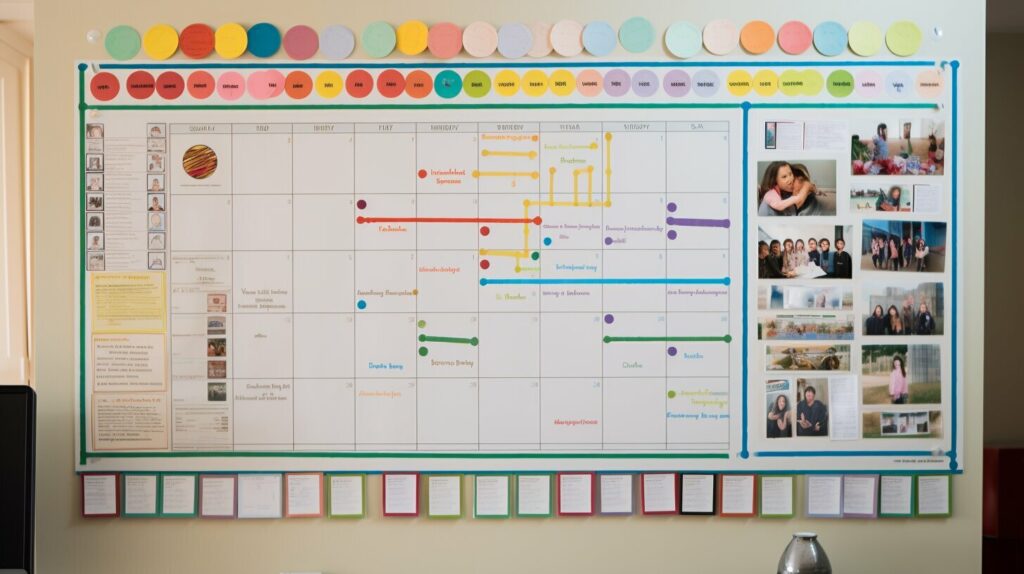As co-parents, effective communication is essential in promoting a healthy upbringing for your child. It can be challenging to maintain a positive co-parenting dynamic, especially when emotions are involved. However, with the right strategies, you can foster understanding and harmony for the well-being of your child.
In this section, we will explore valuable tips and tricks to improve your co-parent communication. From establishing ground rules to managing conflicts, you’ll learn how to navigate common challenges and create a supportive environment for your child.

- Importance of Co-Parent Communication
- Establishing Ground Rules
- Choosing the Right Communication Methods
- Active Listening and Empathy in Co-Parenting
- Managing Conflict in Co-Parenting
- Co-Parenting Schedules and Logistics
- Communicating Boundaries and Expectations
- Resolving Co-Parenting Challenges
- Seeking Professional Support
- Conclusion


Key Takeaways:
- Effective co-parent communication is essential for promoting a healthy upbringing for your child.
- Establish clear and mutually agreed-upon ground rules for effective co-parent communication.
- Choose the most suitable communication method for your co-parenting dynamic.
- Practice active listening and empathy to create a supportive environment for your child.
- Manage conflicts effectively with a focus on the best interests of your child.
Importance of Co-Parent Communication
Effective communication between co-parents is critical in promoting a healthy upbringing for your child. Studies have shown that children who witness positive communication between their parents tend to have better mental health, academic performance, and social skills. In contrast, children with parents who exhibit hostile or ineffective communication are at a higher risk of developing emotional and behavioral problems.
When co-parents communicate effectively, they can make important decisions that affect their child’s life, such as healthcare, education, and extracurricular activities. Additionally, communication facilitates the exchange of information, reduces misunderstandings, and promotes a sense of collaboration and respect between co-parents.
Moreover, the benefits of effective co-parent communication can extend beyond childhood. As children grow up, they may encounter challenges that require the cooperation and support of both parents, such as college applications, weddings, or the birth of grandchildren. By maintaining a positive co-parenting dynamic, parents can ensure that they are there for their child through all of life’s milestones.


“Effective communication is 20% what you know and 80% how you feel about what you know.”
– Jim Rohn
Establishing Ground Rules
Effective communication between co-parents is crucial for the well-being of their child. To ensure a healthy dynamic, it’s essential to establish clear and mutually agreed-upon ground rules. Ground rules set boundaries for communication, prevent misunderstandings, and contribute to a positive environment for co-parenting.
When developing ground rules, it’s important to consider each parent’s communication preferences and prioritize the child’s needs. Ground rules should be specific, measurable, and achievable. They may include protocols for scheduling, responding to messages, and sharing information.
For example:
| Ground Rule | Explanation |
|---|---|
| Response Time | Agree to respond to messages within 24 hours |
| Information Sharing | Agree to share important information about the child promptly |
| Respectful Communication | Agree to communicate respectfully and avoid sarcasm or derogatory language |
| Scheduling Protocol | Agree to provide advance notice for schedule changes and stick to a consistent routine |
Importance of Consistency
Consistency is key to making ground rules effective. Both co-parents must abide by the agreed-upon rules to prevent misunderstandings and ensure adherence to the child’s routine. If one parent consistently disregards the ground rules, it can undermine the co-parenting relationship and create tension.
When disagreements or conflicts arise, it’s essential to revisit the ground rules and find a mutually acceptable resolution. This approach encourages open communication and fosters a collaborative co-parenting environment.
Establishing ground rules may seem challenging, but it is an essential component of effective co-parent communication. With clear and concise ground rules in place, co-parents can reduce misunderstandings, increase trust, and focus on their child’s well-being.


Choosing the Right Communication Methods
Effective co-parent communication requires careful consideration of the different communication methods available. While face-to-face conversations may provide a personal touch, phone calls, emails, and online tools offer convenience and flexibility. Choosing the right communication method can make all the difference in fostering understanding and cooperation between co-parents.
Consider the following factors when selecting a communication method:
| Communication Method | Advantages | Disadvantages |
|---|---|---|
| Face-to-face |
|
|
| Phone calls |
|
|
| Emails |
|
|
| Online tools |
|
|
Remember to prioritize open and honest communication, regardless of the method used. Ensure that both co-parents agree on the chosen method and establish guidelines for respectful and effective communication.


Active Listening and Empathy in Co-Parenting
One of the most crucial aspects of effective co-parent communication is active listening and empathy. It involves not only hearing what your co-parent is saying but also making an effort to understand their perspective and feelings.
Active listening requires full attention, without interruption or distraction. It means acknowledging your co-parent’s words, body language, and tone of voice while being receptive and non-judgmental.
Empathy is the ability to put yourself in your co-parent’s shoes and understand their emotions and thoughts. It involves showing compassion and validating their feelings, even if you do not agree with their views.
Techniques for Active Listening and Empathy in Co-Parenting
Here are some practical strategies for enhancing active listening and empathy in co-parent communication:
- Listen with intent – Pay full attention to your co-parent without interrupting, and consider their words carefully before responding.
- Show understanding – Acknowledge your co-parent’s feelings and thoughts, and express empathy without judgment or criticism.
- Reflect on their words – Repeat or rephrase your co-parent’s message to demonstrate understanding and clarify any misunderstandings.
- Validate their feelings – Show support and understanding for your co-parent’s emotions, even if you do not agree with their viewpoint.
- Be patient – Allow your co-parent to express their thoughts and emotions without rushing to judgment or reacting impulsively.
By implementing these techniques, you can create a compassionate and supportive co-parenting dynamic, where both parties feel heard and understood. This, in turn, can promote a positive and harmonious environment for your child’s well-being.


“Active listening is not just about hearing the words that are being said, but about truly understanding what the speaker is communicating.”
Managing Conflict in Co-Parenting
Effective communication is crucial in co-parenting, but it’s not always easy. Conflicts and disagreements are bound to happen, and it’s essential to handle these situations constructively. Resolving conflicts can prevent misunderstandings, maintain a positive relationship, and promote the well-being of your child. Here are a few tips on how to manage conflict in co-parenting:
- Stay calm: When discussing difficult topics, emotions can run high. It’s important to remain calm and avoid raising your voice or using aggressive language. Take a break if you need to before continuing the conversation.
- Listen actively: Hear your co-parent’s perspective and show that you understand their point of view. Repeat back what they say to ensure that you grasp their position. It’s also important to acknowledge their feelings and validate them.
- Be respectful: Treat your co-parent with respect, even if you disagree. Avoid personal attacks or criticisms and focus on finding a solution that works for everyone.
- Collaborate: Work together to find a solution that benefits your child. Brainstorm ideas and try to find common ground. Compromise may be necessary to reach an agreement.
- Use “I” statements: When expressing your concerns, use “I” statements instead of “you” statements. This approach can prevent your co-parent from becoming defensive and can encourage active listening and empathy.
- Seek professional help: If you’re struggling to resolve a conflict, consider seeking professional help such as therapy or mediation. A neutral third-party can provide guidance and help facilitate a constructive conversation.
Remember that conflict is a natural part of communication in co-parenting. By managing conflicts effectively, you can promote a positive co-parenting dynamic and improve communication for the well-being of your child.


Co-Parenting Schedules and Logistics
Effective co-parenting requires careful coordination of schedules and logistics. By creating a well-structured plan, parents can ensure that their child’s needs are met, and that there is no confusion about responsibilities or expectations.
The first step in managing co-parenting schedules is to establish a clear routine. This can include a schedule for pick-ups and drop-offs, meal times, and bedtimes. By adhering to a schedule, parents can create consistency and stability for their children.
It is also essential to communicate any changes in the schedule in advance. For example, if one parent needs to adjust the pickup time, they should inform the other parent as soon as possible. This can help prevent misunderstandings and ensure that everyone is on the same page.
When it comes to logistics, there are various tools and technologies available to make co-parenting more manageable. Online calendars, for example, can make scheduling appointments and events easier. Co-parenting apps can also be helpful for communication and document sharing.


In addition to technology, parents can also use traditional methods to manage co-parenting logistics. For example, a shared notebook or planner can be used to keep track of important dates and events.
Finally, it is crucial to maintain a positive mindset when dealing with co-parenting schedules and logistics. While it can be challenging to coordinate with an ex-partner, it is essential to prioritize the well-being of the child. By staying focused on this goal, parents can work together to build a successful co-parenting relationship.
Communicating Boundaries and Expectations
Effective co-parenting communication involves establishing clear boundaries and expectations to avoid misunderstandings and promote harmony. When co-parents fail to communicate their expectations and needs, it can lead to conflicts and negatively impact their child’s well-being. Here are some tips to help you communicate boundaries and expectations effectively:
- Be clear: Communicate your expectations and boundaries in a clear, concise manner. Use “I” statements to express your feelings and avoid blaming your co-parent.
- Be consistent: Consistency is key when it comes to co-parenting boundaries. Make sure that you and your co-parent are on the same page and stick to the agreed-upon boundaries.
- Be respectful: Respect your co-parent’s boundaries and expectations as you would want them to respect yours. Remember that the goal is to create a healthy co-parenting relationship for the well-being of your child.
Communication is vital in co-parenting, and setting boundaries and expectations can help co-parents navigate difficult situations and minimize conflicts. Here is an example of a table outlining some possible co-parenting boundaries:
| Co-Parenting Boundary | Description |
|---|---|
| Custody and visitation schedule | Agree on a schedule that works for both parents and the child. |
| Communication method | Agree on the best method of communication and the frequency of communication. |
| Child discipline | Agree on how to discipline the child and consequences for misbehavior. |
| Sharing information | Agree on what information to share about the child’s activities, school, and health. |


Conclusion
Communicating boundaries and expectations is essential in co-parenting communication. Remember to be clear, consistent, and respectful when setting boundaries with your co-parent. By doing so, you can minimize conflicts and promote a healthy co-parenting relationship for the well-being of your child.
Resolving Co-Parenting Challenges
Co-parenting can be a challenging journey, and it’s natural to face obstacles along the way. Here are some common co-parenting challenges and effective problem-solving strategies.
Challenges with Communication
One of the most significant challenges co-parents face is communication barriers. Misunderstandings, lack of clarity, and disagreements can lead to conflict and tension. To overcome these challenges, try to:
- Practice active listening: Give your full attention to the other parent and try to understand their point of view.
- Be clear and concise: Avoid making assumptions and be specific in your communication.
- Use “I” statements: Focus on your emotions and experiences without blaming or accusing the other parent.
Conflicting Parenting Styles
It’s common for co-parents to have different parenting styles, which can lead to disagreements and tension. To address this challenge, try to:
- Establish consistent rules: Agree on basic rules and expectations for your child and communicate them clearly to both parents.
- Compromise: Be flexible and willing to find a middle ground that works for both parents and the child.
- Respect differences: Acknowledge and respect each other’s parenting styles and find ways to work together effectively.
Conflict Resolution
Conflicts are bound to arise in co-parenting, but how you manage them can make a significant difference. To handle conflicts effectively, try to:
- Stay calm: Avoid reacting impulsively and take a break before addressing the conflict.
- Focus on the issue: Stick to the specific problem at hand and avoid bringing up past conflicts.
- Collaborate: Work together to find a solution that satisfies both parties and benefits the child.
Seeking Professional Support
If you’re struggling to resolve co-parenting challenges on your own, seeking professional support can be beneficial. Consider reaching out to a family therapist or mediator who can provide guidance and facilitate constructive conversations. They can also help you develop problem-solving strategies and improve communication.
Remember, the ultimate goal of co-parenting is to provide the best possible environment for your child to thrive in. By working together to overcome challenges and communicate effectively, you can create a positive co-parenting dynamic that benefits everyone involved.


Seeking Professional Support
Co-parenting can be challenging, and sometimes it can be difficult to resolve conflicts and maintain effective communication. Seeking professional support can be beneficial in improving co-parenting dynamics and promoting the well-being of your child.
Therapy can help co-parents work through their emotions and develop effective communication strategies. A trained therapist can also help co-parents learn to separate their personal issues from their parenting responsibilities.
Mediation is another option for co-parents to resolve conflicts in a neutral and collaborative environment. A professional mediator can work with both parties to identify solutions that work for everyone involved.
Remember, seeking professional support is not a sign of weakness or failure. It is a proactive step towards creating a healthy and positive co-parenting relationship. Your child will benefit from seeing their parents work together to prioritize their needs and well-being.


Expert Tip:
“When considering therapy or mediation, look for professionals with experience in co-parenting and family relationships. It’s essential to find someone who understands your unique situation and can provide the right guidance and support.”
Conclusion
In conclusion, mastering co-parent communication is vital for the well-being of your child. By improving communication, you can foster understanding and harmony in your co-parenting relationship.
We explored the importance of co-parent communication and established the significance of clear and mutually agreed-upon ground rules. Additionally, we discussed how choosing the right communication methods, active listening, and empathy can enhance understanding and create a supportive environment.
Managing conflicts, co-parenting schedules and logistics, communicating boundaries and expectations, and resolving challenges were also addressed. It is essential to seek professional support such as therapy or mediation in co-parent communication, as professionals can provide guidance and facilitate constructive conversations.
Emphasizing the Significance of Co-Parent Communication
When parents work together to communicate effectively, they can provide a secure and stable environment for their children. It is crucial to prioritize co-parenting communication and put aside personal differences. The tips and tricks shared in this article can help you improve your co-parenting dynamic and promote a healthy upbringing for your child.



FAQ
What are some tips for improving co-parent communication?
Some tips for improving co-parent communication include setting aside time for regular discussions, actively listening to each other, using “I” statements instead of blaming language, and seeking professional support if needed.
Why is co-parent communication important?
Co-parent communication is important because it promotes a healthy upbringing for your child. It helps create consistency, minimizes misunderstandings, and allows for collaborative decision-making.
How can I establish ground rules for co-parent communication?
You can establish ground rules for co-parent communication by having open discussions with your co-parent, setting boundaries and expectations, and creating a written agreement that outlines how you will communicate with each other.
What are some effective co-parent communication methods?
Effective co-parent communication methods include face-to-face discussions, phone calls, emails, and online tools such as co-parenting apps. Choose the method that works best for both you and your co-parent.
How can I improve active listening and empathy in co-parenting?
To improve active listening and empathy in co-parenting, practice truly listening to your co-parent without interrupting, validating their feelings, and putting yourself in their shoes to understand their perspective.
How can I manage conflicts that arise during co-parent communication?
You can manage conflicts during co-parent communication by staying calm and composed, using constructive communication techniques, seeking compromise, and considering mediation or therapy to resolve deep-rooted conflicts.
Any tips for managing co-parenting schedules and logistics?
To manage co-parenting schedules and logistics effectively, create a shared calendar, communicate in advance about any changes or adjustments, and consider using co-parenting apps to streamline coordination.
How can I communicate boundaries and expectations with my co-parent?
Communicate boundaries and expectations with your co-parent by having a respectful conversation, being open and clear about your needs and boundaries, and seeking compromise when necessary.
What are some strategies for resolving co-parenting challenges?
Strategies for resolving co-parenting challenges include maintaining a child-focused mindset, seeking guidance from professionals if needed, finding common ground, and practicing effective problem-solving techniques.
When should I consider seeking professional support in co-parenting?
Consider seeking professional support in co-parenting if you and your co-parent are unable to effectively communicate, if conflicts become unmanageable, or if you need guidance navigating complex issues related to co-parenting.
What is the conclusion regarding co-parent communication?
The key takeaway is that mastering co-parent communication is essential for the well-being of your child. By implementing effective strategies, setting boundaries, and seeking professional support when necessary, you can create a harmonious co-parenting dynamic that benefits everyone involved.





Leave a Reply